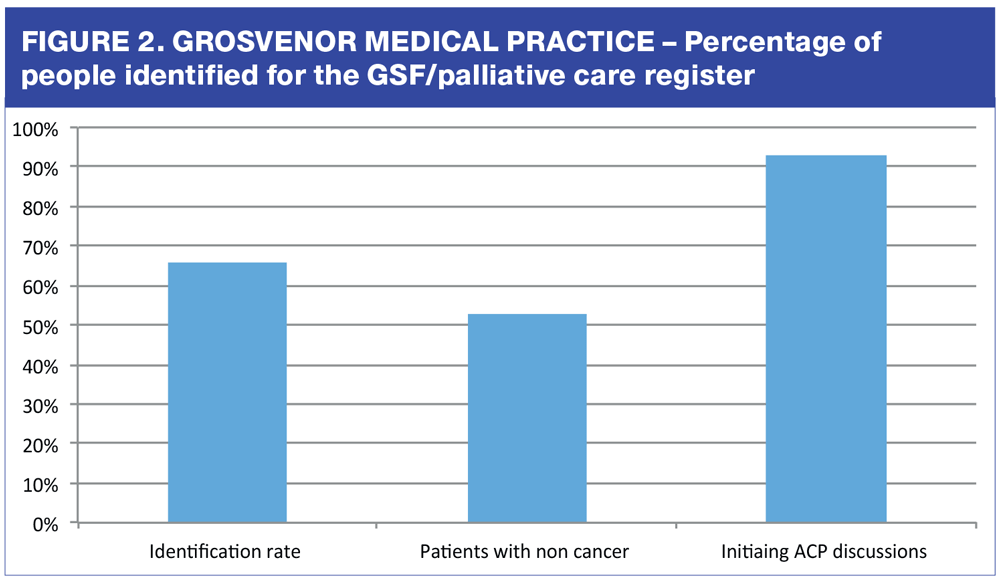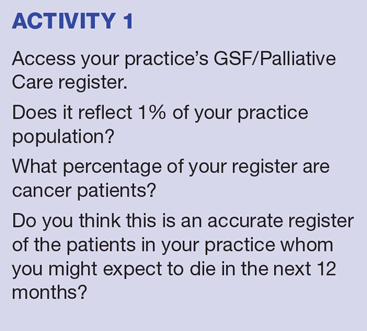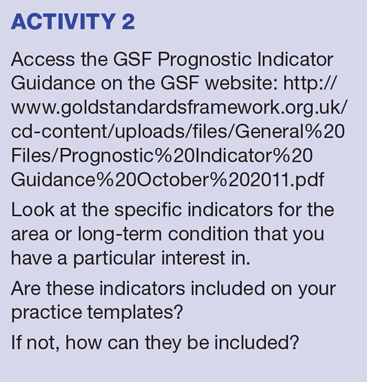End of life care: doing it better
Professor Keri Thomas,
Professor Keri Thomas,
MB BS MRCGP DCH Msc (Pall Med).
Founder and Clinical Director, National Gold Standard Framework (GSF) in End of Life Care
Tom Tanner
GSF Associate
Julie Armstrong Wilson
Lead Nurse Primary Care and Hospitals, GSF
‘Seeing the destination, we can better plan the journey’. In end of life care, opportunities may be missed to offer support and help to people to live fully and, when the time comes, to die well. One per cent of the population are in their last year of life, yet only a minority of these people will have been recognised, asked about their wishes and preferences, and offered proactive care to help them live well and die well. Can we do better in end of life care?
As an ageing population places ever-greater demands on practices, with many more people living longer with long term conditions (LTC), multi-morbidity, frailty and dementia, end of life care (EOLC) is widely recognised as a challenging area for primary care teams. A range of reports and studies have highlighted continuing challenges in health and care services, and expected standards of personalised, high quality, joined-up care for people nearing the end of their lives are not always being delivered.1,2 However, more can be done proactively to ensure patients are recognised earlier, leading to more planned care, centred on the needs, wishes and preferences of patients.
EOLC is defined as care in the final year of life, rather than just care in the final days.3 The provision of a more proactive approach, with earlier planning, can ensure that people in the last year of life are able to live their final year as well as possible, in the place and in the manner of their choosing. EOLC can be seen as a litmus test for all our care – get this right and all other things can follow – and it can often be a great trigger for enhanced teamwork within GP practice teams. However, as demands increase and resources tighten these are challenging times. With increasingly intense media focus, changing policy recommendations, inspection by regulators and growing public awareness, this crucial area has never been more important to get right, and possibly never as challenging.
THE IMPORTANT ROLE OF THE PRACTICE NURSE
Practice nurses play a key role within primary care teams in EOLC, a role that is becoming increasingly well recognised as the focus on those with non-cancer and long term conditions intensifies. You could consider integrating proactive EOLC within your usual work with patients with LTC, building on your long term relationships with them. You are therefore ideally placed to improve EOLC in your practice.
Practice nurse have the skill set, the opportunities presented by caring for people with LTC and the abilities to make a very important contribution. A recent report for Health Education England (HEE) affirmed the importance of education in EOLC for all generalist staff, including practice nurses and others in primary care teams,4 and there are soon to be agreed competencies in EOLC defined by HEE and RCN.
EARLY IDENTIFICATION
An estimated 1% of the population are in their last year of life. All GPs have palliative care/Gold Standards Framework (GSF) registers, mainstreamed in 2004 through the Quality Outcomes Framework (QOF) (basic or bronze level GSF), but there is a lot more that can be done. Only about a quarter of all people who die have been identified and are on the register,5 and many GPs are trying to increase the numbers of patients on their palliative care/GSF registers.
Practice nurses have a key role in the earlier identification of patients in their final year of life. The long-term relationships which practice nurses develop with patients enable them to discern significant changes and initiate discussions to establish their needs, wishes and preferences. These Advance Care Planning (ACP) discussions can include choices about the preferred place of care and, importantly, can be reviewed regularly.
By working with their GP colleagues, practice nurses can help update and improve the GPs’ palliative care or GSF Registers and support discussions of these patients at regular team meetings. There may be additional skills they can fine tune to improve their contribution, such as identification of degrees of frailty, using the indicators for frailty or the Electronic Frailty index.
The GSF primary care programmes can support practices to improve earlier identification of patients,6 and in particular those with non-cancer and those from care homes The GSF Prognostic Indicator Guidance,7 is a tool which many practices have adopted and found to be a valuable means of identifying patients in the final years, months or weeks of life at an earlier stage. It has also been widely used internationally and in different settings, and there is now strong evidence of its use in aiding the identification of the proportion of patients in their last year of life in hospitals.8 It lays out a simple step-by-step process. Box 1 describes some of the specific clinical indicators of decline and more detailed information can be found on the GSF website.
Considering whether patients might be in the final stage of life is not an accurate science but more of an intuitive ‘insurance’ way of thinking to enable proactive care to be initiated early and ensure people live out that final stage of life as well as possible – to ‘hope for the best but prepare for the worst’.
ADVANCE CARE PLANNING (ACP)
Earlier planning can ensure earlier discussions, or ACP, about what is important to the patient: what they do and don’t wish to happen, as well as who will speak for them and Lasting Power of Attorney. These discussions help clarify their thoughts and preferences on issues such as repeated hospital admissions, and can lead to better preparation for later decline as well as more practical help. It can also assist discussions with family and carers. ACP is a key part of good end of life care and is included as one of the important steps of GSF.9 These discussions form the basis of an agreed plan which should shape ongoing care for these patients in their final months. This should then be shared with other health and social care providers and, with regular reviews, significantly increases the likelihood of good care and reduced hospitalisation, right up until the end of life.
Having these discussions with patients can be very challenging and yet can also be a natural part of our conversations as we talk about their thoughts and feelings, hopes and expectations. Sometimes there is the sense that you are entering an important discussion, and it is even more important to respond with a gentle silence rather than feel you need to have all the answers. This is where being with people, holding the present moment as they start to work out their feelings, is essential. See Resources and Further Reading at the end of this article for sources of further information and training in ACP.
In addition to the important clinical decisions that need to be discussed, including ‘do not attempt resuscitation’ orders and place of care, these discussions can also reap great reward if they are truly holistic, encompassing an individual’s wider spiritual and personal wishes.
TRAINING IN EOLC
The National GSF Centre is the leading provider of quality improvement training in EOLC for generalist frontline staff in the UK.10 The Gold Standards Framework Primary Care Programme began in 2000 and, by 2010, most practices had adopted basic level GSF, including a register of these patients and holding meetings to discuss them. Following a systematic review of GSF in primary care, there is good evidence for the benefit of this approach.11 Accreditation is supported by the General Medical Council. More than 95% of GP practices in England and Wales have introduced GSF to foundation level and a further 600 have undertaken the GSF Going for Gold or Silver programme.12,13
GSF training is designed to provide practice nurses and other clinical colleagues with the tools to complement their existing knowledge, to assist them to achieve the goals of:
- Increasing the number of people on the register, specifically those with a non-cancer diagnosis and from care homes
- Enhancing the supportive care register, utilising the blue code to encompass the more vulnerable patients
- Offering ACP discussions to deliver care in line with patient wishes and preferences
- Reducing unnecessary hospital admissions through improved communication and coordination of care.
As well as teaching methods of identifying people from care homes and with non-cancer conditions earlier, GSF training supports the use of early alerting, coding and an IT risk stratification development, known as the GSF IT Tool to support early recognition of people in the last year of life.14 GSF training also enables better information sharing (through locality registers), improved communication with patients and families (through ACP discussions) and enhanced cross-boundary care to reduce excessive time in hospital. It helps people live well and die well where they choose.
Some practices choose to participate in the GSF Silver programme supported by the RCGP. This consists of a two-day course with homework between the workshops. GSF Gold training is a practice-based learning programme involving six one-hour modules over six months, giving the whole team the opportunity to work with the resources provided and embed the learning. The aims of both are the same; to help the whole practice team improve identification and assessment of patients, and planning of care. And it really is the whole team that benefits and takes on a key role in the care of patients as they enter their final months. Practice nurses are central to this, but administrative staff and receptionists also play a critical part.
Following GSF training many practices then progress towards accreditation, with specific evaluations, a portfolio and an assessment visit. These practices are examples of best practice, demonstrating what it is possible to achieve. A key part is the inclusion of the whole team in EOLC and there is a special place for the role of the Practice Nurse.
ACHIEVEMENTS OF GSF ACCREDITED PRACTICES
Accredited teams have shown considerable improvements in key outcomes in end of life care, such as early identification, more ACP discussions and more patients being able to live and die where they choose.15 (Figure 1)
One GP practice, Grosvenor Medical Centre in Stalybridge, a recent recipient of the GSF Quality Hallmark Award, was inspired to go to great lengths to improve the care it provides to patients approaching the end of life. It has achieved remarkable results, and the practice nurse, Laura Burton, spearheaded the initiative. Her background, working in nursing homes, inspired an interest in and aptitude for end of life care. Grosvenor was one of seven practices in the CCG to sign up to the GSF training and, after the second session, the team decided on a radical plan – to visit and assess all 300 patients aged over 75. In three months, Laura and a colleague carried out 155 assessments, adding 36 patients to the register.
‘It was quite an eye-opener,’ says Laura. ‘We picked up on patients who we definitely would not have known about otherwise. The assessments consisted of a general health check, a falls risk assessment, risk of dementia and any other long term conditions.’
Having addressed identification, Laura and her colleagues moved on to look at how they planned and assessed the care they provided. The practice was a pilot site for Electronic Palliative Care Co-ordination Systems (EPaCCS), which helped ensure information passed more smoothly to colleagues in Out of Hours and the ambulance service. Laura also decided to open up the GSF meetings, which she chairs every 4 to 6 weeks, to the widest possible group of fellow professionals, from Macmillan, the district nursing team, long term conditions team, palliative dementia specialist from the local hospice and the local end of life care facilitator who was the gateway into care homes in the locality. The administrative staff in the practice also attend the meetings where they are encouraged to raise concerns about the GSF patients. As well as looking ahead and planning care, these meetings are also an opportunity to reflect on the deaths that have occurred.
One major challenge to planning care is knowing patients’ wishes. Laura says that she and her nursing colleagues struggled to engage patients in these difficult conversations. But, with the help of practical examples and tools provided in the GSF training, they have become more confident. And the GSF emphasis on holistic care, taking it beyond the clinical, ties in with Laura and her colleagues’ philosophy of engaging patients in discussions around a range of issues that include what they’d like to achieve before their last days.
Laura says that the biggest benefit has been continuity of care. ‘Previously, we would largely have handed over responsibility to the district nursing team. It’s now a case of the DNs entering our team rather than the other way round. Now we stay involved up to the end and the way that we do the assessments ensures that patients feel well cared for.
‘I get a huge sense of job satisfaction – especially when we achieve a “good” death. Our greatest role is in identifying patients – those not with cancer. We are best placed to do that.’
Prior to the GSF training there were 16 people on the register and that’s risen to 44. More than 90% are now offered ACP discussions and all of those have their wishes recorded. Cancer patients accounted for three quarters of those on the register, whereas now they make up less than half. (Figure 2)
And Grosvenor is not alone. There are a growing number of practices adopting this approach and experiencing the twin benefits of improved patient care and enhanced job satisfaction. At Macklin Street Surgery in Derby, Dr Sally Giovanelli says: ‘Everyone in the team is really engaged and involved, that includes the receptionists, practice nurses, business manager and triage nurse. Being able to provide a good death is really important for a family and really humbling. It’s one of the most important things we can do as a practice and that’s why we are passionate about it.’
SUMMARY AND RECOMMENDATIONS
According to a national primary care survey, and recent localised QOF figures, only about a quarter of patients who die have been identified and included on the GP practice palliative/supportive care/GSF register as being likely to be in their final year of life, and only a quarter of these are non-cancer patients, so we clearly have some scope to improve.16 There is also evidence that early identification leads to more proactive, better coordinated care, with more people dying in their preferred place of care.4
As a practice nurse you have the opportunity to build long-term relationships with patients and to help them consider care management that will prevent future crises or hospital admissions. This privilege places you in an ideal position to identify deterioration in your patients, as part of your usual duty and role, but you may need to ‘sharpen your antennae’ to pick up patients who might be in their final year of life.
To improve your early recognition of deterioration in your patients there is training available and well-validated tools, such as the GSF Prognostic Indicator Guidance to help you. Asking the ‘surprise question’ of all patients and focussing on those with obvious declining health, for example those over 75 years with LTC with repeated hospital admissions, can help identify patients to be included on the practice GSF/Supportive care register. Their care needs can then be regularly discussed at practice meetings.
When there is an established relationship with patients, ACP discussions can then be initiated so that measures can be put in place to help them remain at home, if that is their wish, and to prevent crises and reduce hospitalisations.
A ‘good’ death is something that we would all wish for and as good a life before death is something that all patients would want, with more time at home with those they love and less time spent in hospital for crisis admissions, fewer out of hours calls and A&E visits. With appropriate training you can be in a position to help patients plan ahead so that they can live as well as possible and, when the time comes, die well in their preferred place. 1,5,10
REFERENCES
1. Neuberger J, Aaronovitch D, Bonser T, et al. Independent Review of the Liverpool Care Pathway: More Care Less Pathway, 2013 https://www.gov.uk/government/uploads/system/uploads/attachment_data/file/212450/Liverpool_Care_Pathway.pdf
2. National Institute for Clinical Excellence. Care of dying adults in the last days of life. London: NICE. 2015 https://www.nice.org.uk/guidance/service-delivery--organisation-and.../end-of-life-care
3. General Medical Council (2010) Treatment and care towards the end of life: good practice in decision making. Manchester: GMC 2010 www.gmc-uk.org/static/documents/content/End_of_life.pdf
4. Health Education England. Training and education in end of life care. 2016 https://www.hee.nhs.uk/sites/default/files/documents/091015-HEE-End-of-life-Care-Report_0.pdf
5. The GSF National Primary Care Audit 2009/10 http://www.goldstandardsframework.org.uk/evidence http://www.goldstandardsframework.org.uk/cd-content/uploads/files/Library%2C%20Tools%20%26%20resources/EOLC%20in%20Primary%20Care%20national%20snapshot%20-%20Key%20Findings.pdf
6. GSF. Evidence that use of GSF improves early identification of patients in difference settings, 2016. http://www.goldstandardsframework.org.uk/cd-content/uploads/files/1%20%20vs%204%20%20Evidence%20that%20use%20of%20GSF%20Improves%20identification.pdf
7. GSF/RCGP. GSF Prognostic Indicator Guidance, 2011 http://www.goldstandardsframework.org.uk/cd-content/uploads/files/General%20Files/Prognostic%20Indicator%20Guidance%20October%202011.pdf
8. Milnes S, Orford NR, Berkeley L, et al. A prospective observational study of prevalence and outcomes of patients with Gold Standard Framework criteria in a tertiary regional Australian Hospital. BMJ Supportive & Palliative Care 2015; doi:10.1136/bmjspcare-2015-000864http://spcare.bmj.com/
9. GSF. How GSF helps earlier identification. http://www.goldstandardsframework.org.uk/cd-content/uploads/files/1%20%20vs%204%20%20Evidence%20that%20use%20of%20GSF%20Improves%20identification.pdf
10. GSF. Advance care planning, 2016 http://www.goldstandardsframework.org.uk/advance-care-planning
11. GSF. Primary care training programme. http://www.goldstandardsframework.org.uk/primary-care-training-programme
12. Shaw K, Clifford C, Thomas K et al. Improving end-of-life care: a critical review of the Gold Standards Framework in primary care Palliative Medicine 0(00) 1–13 doi:10.1177/0269216310362005 http://www.goldstandardsframework.org.uk/cd-content/uploads/files/Primary%20Care/Critical%20Review%20of%20GSF%20in%20Primary%20Care.pdf
13. GSF in Primary Care, 2016. http://www.goldstandardsframework.org.uk/cd-content/uploads/files/Primary%20Care/GSF%20in%20Primary%20Care%202pp.pdf
14. GSF. GSF Silver course for End of Life Care. http://www.goldstandardsframework.org.uk/gsf-silver-course-for-end-of-life-care
15. GSF. IT solutions training programme. http://www.goldstandardsframework.org.uk/it-solutions-training-programme
16. GSF. The 2015 GSF Primary Care Accreditation Quality Hallmark Awards. http://www.goldstandardsframework.org.uk/cd-content/uploads/files/GSF%20Accredited%20GP%20Practices%20%20flyer%20%20v5%20-%20final%282%29.pdf
Related articles
View all Articles







